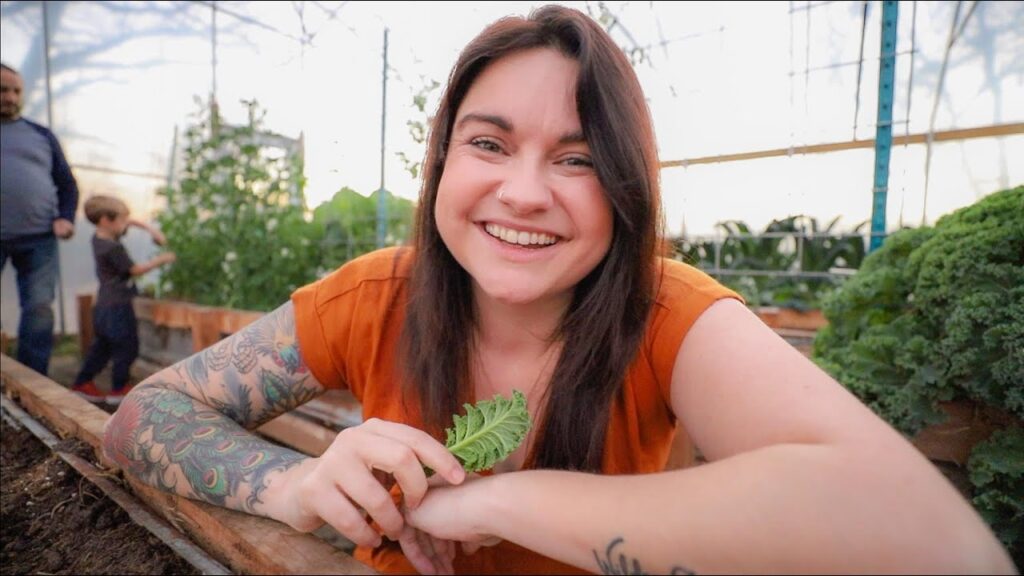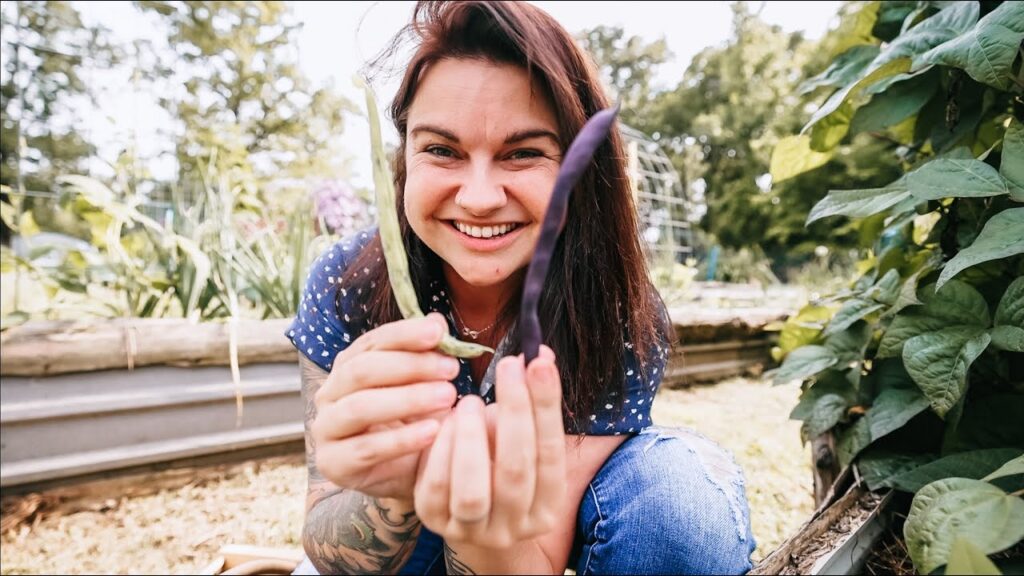Planning your garden out ahead of time is crucial to having a successful growing season. There are tips and tricks on planning your garden layout that you don’t want to overlook. In this post, I’ll be sharing my best tips on how to plan your garden, direct sowing vs. seed starting, growing seasons and so much more.

Growing Your Own Food
I have received so many messages with basic questions about gardening but they are so often prefaced by, “I’m so sorry this is a stupid question…”
That breaks my heart because, the truth is, growing your own food is not the mainstream. We don’t have an abundance of simple resources to use and this is not common knowledge.
I feel strongly that those who have the information should be very giving with it and those who need the information should not be apologetic about needing it. If this is something that we really want to bring back to the forefront of our culture, it has to happen with mentorship and tutelage, and the generosity of what we know.
In fact, I designated an entire YouTube video called “about the stupid questions”. Please give it a watch if you've ever felt ashamed about asking basic or “stupid” questions.
It's because of these questions that I am putting this information out there for you. When it really comes down to it though, you just have to start. Growing something just one time is going to give a clear idea of what you want to do. You CAN grow your own food!

Plant Hardiness Zones & Growing Seasons
The first thing you need to know when planning and starting a garden is what growing zone you are in. The hardiness zone rating tells you which plants can survive in your particular climate based on the extreme low temperatures you can expect in your area.
How do I Find My Growing Zone?
A helpful resource for finding your growing zone is the USDA Plant Hardiness Zone Map. You can enter your zip code or use the + and – buttons on the top left of the map to zoom in on your area to find your exact growing zone. Refer to the map key for your hardiness zone.
For example, where we live in South Carolina has a hardiness zone of 8a (where we used to live in Conway, Arkansas was zone 7b). It's going to be a fun first year of gardening to begin experimenting with some new crops.
In zone 7b we could grow fig trees and artichokes because it doesn't get cold enough during the winter to kill them. You will want to write your zone down for reference later on. When purchasing plants and seeds, look for plants that will grow well in your hardiness zone.
An apple tree might be listed for zones 3-6, so that specific tree isn’t a good choice for zone 7b.
Because most vegetable plants are annuals, they will be planted, harvested and then replanted from seed the next year. It’s a good idea to grow crops that do well in your zone, but the hardiness zone is going to pertain more to perennials than annuals.

When Is My Growing Season?
For growing annuals, you need to figure out the length of your growing season. The growing season length is estimated by using the approximate dates of the first and last frost of the year.
It will be different in different areas (and sometimes even vary within a certain zone, so it’s always a great idea to ask around to neighbors who garden to get a better idea of actual first and last frost dates).
Remember it is just an estimate. There is no way to forecast the exact date when there will be no more killing frosts. Especially if you live in a remote area, you may have to do a little more searching. But, for most, Google will do just fine.
The Farmer’s Almanac is a good resource as well. You can find average frost dates by region on their website. When planting gets closer, you will be paying attention to the actual forecast and weather your area is experiencing that year, but the Farmer’s Almanac estimate is useful for seed purchasing purposes.
Using Conway, Arkansas as an example again (because I don’t yet have enough garden seasons behind me on our new homestead), the estimated risk of frost is from October 31st to April 1st. This equates to 213 days between the last frost on April 1st to the first frost on October 31st.
Now I know that my growing season is roughly 213 days. To be honest, I’d really be pushing it to be growing anything for the early and late parts of that 213-day growing season, but I shouldn’t get a killing frost.
I’m thankful to be in the south where we have a nice long growing season. Some of you have short growing seasons that are closer to 100 days. That does impact what seeds you will want to buy and what plants you will be able to grow.

Direct Sowing Versus Seed Starting
Direct sowing is starting your seeds directly in your garden soil. Seed starting refers to planting the seeds indoors or in a greenhouse and then transplanting them into your garden some weeks later.
I have an extensive video with everything you need to know about direct sowing versus seed starting so I will not go into great detail about that here. I will say that if you live in a place where you have a long growing season, you can direct sow things that typically would be started inside.
I've heard that plants will be hardier that way, in the same way that volunteer plants are super strong. I have always started those varieties anyway because, in my experience, I will get a harvest sooner.

When Will Plants Come to Maturity
Seed catalogs and online stores will usually tell you “this is an 80-day variety” or “this is a 100-day variety”. Using that information and knowing your growing season length gives you an idea if that plant will be able to come to maturity and produce a harvest before your growing season ends.
For squash, cucumbers, melons, and other things that are more commonly direct sown, this is the date when the seed goes into the ground to the date of harvest.
For varieties commonly started and then transplanted, it is important to know they are counting the days to ripe fruit from when you transplant it into the ground, not from the day it is started. Things like tomatoes, peppers and eggplant will be listed this way. It is generally assumed these will be started for 6 weeks before planting. So plan for 6 weeks to start and then the number of days listed.
Don’t get too hung up on trying to count out your days and look over your calendar. I am of the mind that it is best to just try. If it doesn’t work, you can chalk it up as a learning experience for next year. You can really drive yourself crazy and discourage yourself from gardening at all if you are too hung up on this. If you live in a northern area, try starting your tomatoes a little earlier and allow them to grow 10 weeks before transplant to give them a long enough growing season.
A good gauge is to look at what the people around you are growing. Ask a neighbor who gardens or check out the local farmer’s market. Look and ask people what they are having success growing. They might recommend a variety that grows great where you live or tell you that they have to use a greenhouse to grow tomatoes. Ask questions. If someone tells you they loved a certain variety, ask them, “Why did you love it? Were there any drawbacks to this?” Find out why they have their opinion and apply it to your garden.
When To Plant Cold Weather Varieties
There are some crops that you can grow under freezing temperatures. I start planting out my cold weather stuff like root vegetables, brassicas, lettuces, carrots, peas, and calendula flowers about a month and a half before the last frost date with maybe just a light cover.
How Much To Plant In Your Garden

Now that you have decided the varieties you want to grow and when to plant things in your garden, you’re probably wondering “how much do I actually need to plant?”
There are so many factors that come into play here. There is not a one-size-fits-all answer. I have seen all the charts that tell you to grow this many plants for a family this size, but I don’t believe we can feasibly apply that. A structured formula just doesn’t work because there are too many variables. It will just have to come from experience.

One variable to consider is how much of each food does your family like to eat. In my family, we have three people who could live off of tomatoes all summer and the rest won’t eat fresh tomatoes at all.
You may have a smaller family but eat more tomatoes than a large family. Or you may do a lot of canning of tomato products.
Another variable is the weather. The first year I planted cucumbers, I planted 10 plants. We had a great year for growing cucumbers and, by the end of the season, we were all so tired of eating cucumbers that the pig wouldn’t even eat them anymore! I canned all that I could, but I could not keep up.
The next year, I cut back and only planted a couple of plants. We had a crazy hot spring and my cucumbers were a hot mess of fungus and failure. I didn’t have any cucumbers to can that year. Thankfully we had all the pickles from the year before. Had I only grown a few plants the first year, it would’ve been plenty. The second year, it would’ve been better if I had planted a lot of plants. So you learn by trial and error, too!
You can’t know the weather ahead of time, but you can know what you want to do and estimate general productivity.
- Do you want to can or dehydrate or maybe both?
- Want to put food up in your freezer?
- Desire a ton of produce for fresh eating?
- Maybe you want to be able to give produce to your neighbors, family, and friends?
If you only want to eat fresh out of your garden, you don’t need a large garden. Here is my overall advice if you are just getting started:
- Grow something that excites you and that you are eager to have and taste.
- Grow other things that you are confident will grow successfully. I know there is a temptation to only plant unusual stuff, which is fun. I like to do that and think it is great to grow rare varieties. But every year I also grow some popular varieties like the National Pickling Cucumber or the Boston Pickling Cucumber. These varieties are in so many people’s gardens, but you have to remember that there is a reason they are so popular.
- Remember, you don’t have to grow a ton. It would be better for you to grow a small garden and have success than to overdo it with a large garden and be overwhelmed.
- If you are definitely committed to canning a specific food, make sure that you grow enough of it. Plant a whole long row of that food. If you plant just a few plants, you may not ever have enough ripe at the same time to can it.
If you are ready to start shopping for seeds, my seed shopping method may be helpful.
I hope that you feel encouraged and have some clarity now. I want to give you the courage to try and the bearing to go into it realistically. Have fun! Get excited! Gardening is a beautiful thing.
Bless you and I hope you have a wonderful experience.

















